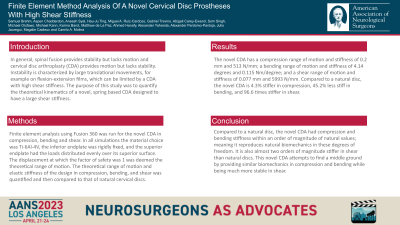Finite element method analysis of a novel cervical disc prostheses with high shear stiffness
Finite Element Method Analysis of a Novel Cervical Disc Prostheses with High Shear Stiffness
Friday, April 21, 2023


Samuel N. Brehm, BSME (he/him/his)
Medical Student
Washington University School of Medicine
Corpus Christi, Texas, United States
ePoster Presenter(s)
Introduction: In general, spinal fusion provides stability but lacks motion and cervical disc arthroplasty (CDA) provides motion but lacks stability. Instability is characterized by large translational movements, for example on flexion-extension films, which can be limited by a CDA with high shear stiffness. The purpose of this study was to quantify the theoretical kinematics of a novel, spring based CDA designed to have a large shear stiffness.
Methods: Finite element analysis using Fusion 360 was run for the novel CDA in compression, bending and shear. In all simulations the material choice was Ti-6Al-4V, the inferior endplate was rigidly fixed, and the superior endplate had the loads distributed evenly over its superior surface. The displacement at which the factor of safety was 1 was deemed the theoretical range of motion. The theoretical range of motion and elastic stiffness of the design in compression, bending, and shear was quantified and then compared to that of natural cervical discs.
Results: The novel CDA has a compression range of motion and stiffness of 0.2 mm and 513 N/mm; a bending range of motion and stiffness of 4.14 degrees and 0.115 Nm/degree; and a shear range of motion and stiffness of 0.077 mm and 5993 N/mm. Compared to a natural disc, the novel CDA is 4.3% stiffer in compression, 45.2% less stiff in bending, and 96.6 times stiffer in shear.
Conclusion : Compared to a natural disc, the novel CDA had compression and bending stiffness within an order of magnitude of natural values; meaning it reproduces natural biomechanics in these degrees of freedom. It is also almost two orders of magnitude stiffer in shear than natural discs. This novel CDA attempts to find a middle ground by providing similar biomechanics in compression and bending while being much more stable in shear.
Methods: Finite element analysis using Fusion 360 was run for the novel CDA in compression, bending and shear. In all simulations the material choice was Ti-6Al-4V, the inferior endplate was rigidly fixed, and the superior endplate had the loads distributed evenly over its superior surface. The displacement at which the factor of safety was 1 was deemed the theoretical range of motion. The theoretical range of motion and elastic stiffness of the design in compression, bending, and shear was quantified and then compared to that of natural cervical discs.
Results: The novel CDA has a compression range of motion and stiffness of 0.2 mm and 513 N/mm; a bending range of motion and stiffness of 4.14 degrees and 0.115 Nm/degree; and a shear range of motion and stiffness of 0.077 mm and 5993 N/mm. Compared to a natural disc, the novel CDA is 4.3% stiffer in compression, 45.2% less stiff in bending, and 96.6 times stiffer in shear.
Conclusion : Compared to a natural disc, the novel CDA had compression and bending stiffness within an order of magnitude of natural values; meaning it reproduces natural biomechanics in these degrees of freedom. It is also almost two orders of magnitude stiffer in shear than natural discs. This novel CDA attempts to find a middle ground by providing similar biomechanics in compression and bending while being much more stable in shear.
